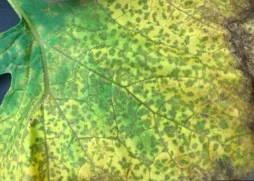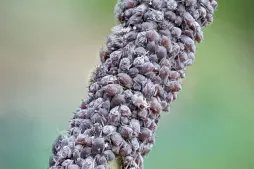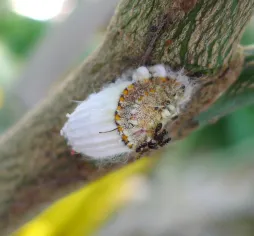Kalanchoe thyrsiflora, a succulent with a fatal flowering habit
Kalanchoe thyrsiflora is a plant of the Crassulaceae family native to South Africa. Grown indoors for its graphic foliage, it offers spectacular flowering before dying.
How to recognize Kalanchoe thyrsiflora?
A succulent perennial, Kalanchoe thyrsiflora easily reaches 60 centimetres in height. It produces numerous shoots at its base, giving it a bushy habit.
Unlike Kalanchoe orgyalis and Marbled Kalanchoe, the stem is not always visible. Kalanchoe thyrsiflora grows in a rosette of leaves. On the upper stages, the leaf blades are almost erect.
The rounded, fleshy, flattened leaves are 15 cm long. Gray-green, they are covered with a silvery bloom. In sufficient light, the margins of the leaf blades turn red.
After three or four years, Kalanchoe thyrsiflora flowers. A flowering spike over a metre long emerges from the heart of the foliage. It hosts a cluster of compact green cymes: the thyrses. They support the yellow, tubular flowers.
In South Africa, Kalanchoe thyrsiflora is used in traditional medicine. It is used to make poultices and protective amulets. But all parts of the plant are toxic, especially to animals. Leaves and flowers cause neurological and muscular disorders. If you have dogs or cats, keep your succulent out of their reach.
Our maintenance tips
Although kalanchoes with thyrse flowers can't stand the cold, they adapt very well to the dry air of our apartments, even in winter. Regular watering and a little care are all it takes to grow them indoors.
Watering
Water your Thyrse flowered Kalanchoe when the soil surface is at least three centimetres dry.
Use non-calcareous water at room temperature, such as rainwater.
After 20 minutes, empty the planter or saucer. Stagnant water can rot the roots.
Repotting
Every spring, repot your Kalanchoe thyrsiflora to give it more space.
Get a pot with holes in it. Over time, foliage can become imposing. To prevent its weight from tipping the container over, choose a heavy model, in terracotta or ceramic for example. Line the bottom with pebbles.
This variety appreciates rich, well-drained soil. You can combine potting soil for flowering plants or heather soil with perlite or pozzolan. Pour in a layer of substrate, then plant your specimen in the center. Fill in with the rest of the mixture.
Water for the first time to eliminate air bubbles and encourage rooting.
Fertilization
To promote the growth of your Kalanchoe thyrsiflora, apply fertilizer in spring and summer.
Feed your Kalanchoe thyrsiflora with a flowering plant fertilizer twice a month to support flowering.
Prune
After flowering, remove wilted flowers.
Use a clean, sharp tool, such as a pair of scissors or pruning shears.
Use a clean, sharp tool, such as a pair of scissors or pruning shears.
Cutting
Cutting is carried out during the strong growth phase, generally in spring and early summer.
Locate the joint between the young shoot and the mother plant. Separate them using a clean, sharp utensil, such as secateurs or a knife. The larger the reject, the greater your chances of success.
Line a small, perforated pot with potting soil for seedlings and cuttings. Using a pen or pick, make a pilot hole. Plant your cutting, taking care not to bury the leaves.
Place your cutting in a sunny spot and spray the substrate regularly with water to keep it moist.
Diseases / Threats
Information
| Family | Crassulaceae - Crassulaceae |
| Type | Kalanchoë - Kalanchoe |
| Species | Thyrse flowered Kalanchoe - Kalanchoe thyrsiflora |
| Lifecycle | Perennial |
| Foliage | Evergreen |
| Exposure | |
| Substrats | |
| Planting method |
In pots |
| Categories | |
| Tags |
Beginner Flowery Fritillary Toxic |
| Origin |
South Africa |
| Hardiness (USDA) | 10b |
| Leaf color |
|
| Flower color |
|
Discover plants from the same family
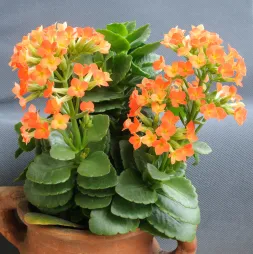
Blossfeld's Kalanchoe
Discover
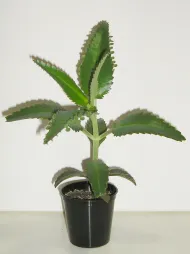
Kalanchoe of Daigremont
Discover
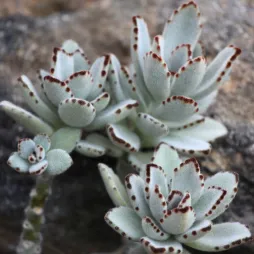
Panda plant
Discover

Kalanchoe orgyalis
Discover











